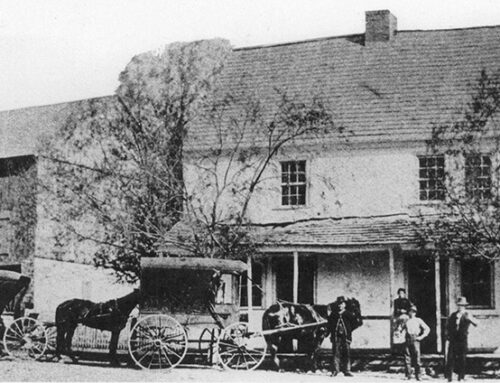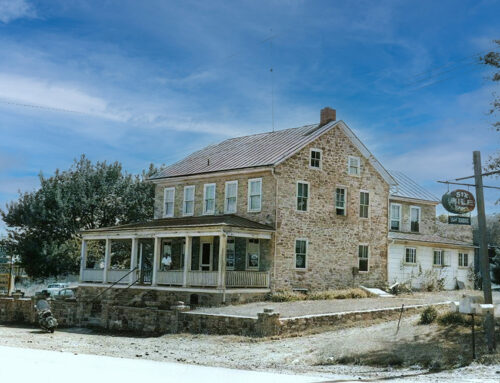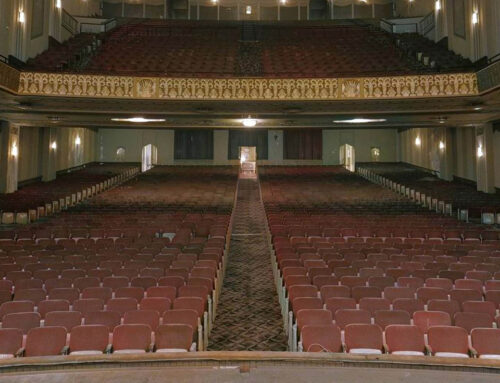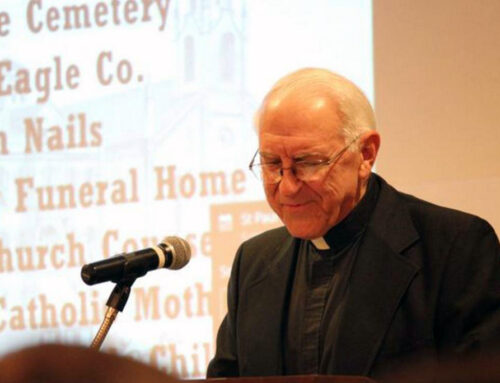In 1904, Dr. Levi Mengel, a science teacher at the Reading School District, sought permission from the district to purchase scientific and anthropological materials to aid in his vision of providing a “sensory education” to motivate his students to participate and to enrich their learning experience. Permission was granted, and the teaching collection grew such that, in 1907, the School District needed to convert the third floor of the Eighth and Washington Streets Administration Building into a museum to house the objects. By 1913, it was suggested that fine art be incorporated into the museum, and the first paintings were donated. The name of the institution became the Reading Public Museum and Art Gallery.
Below: The Reading School District administration building on the southwest comer of Washington and Cedar Streets housed the first Reading Public Museum and Art Gallery. The famous Philadelphia architect Frank Furness designed this building for use as a boys’ high school prior to the Alexander Forbes Smith designed Boys’ High, completed in 1906, which has served as Readings City Hall since 1928.

Before long, the space allotted to the museum proved inadequate. In 1922 with a change in the Reading schools administration, it became clear that the current school buildings in Reading were obsolete and rundown. A $3.5 million loan was necessary to construct, among other buildings, the four junior high schools.
Mengel saw this as an opportunity for the funding of a new museum building and began a petition drive to educate the public on its necessity. His petitions yielded 31,638 city voters’ signatures in favor of the school loan, which would provide $475,000 for a new museum building. The loan proposal was put on the ballot, and voters approved by a 4-1 margin.
After consultation with architects and museum professionals, Mengel recommended the museum be placed in City Park fronting 11th Street between Washington and Walnut. Politics and egos nearly doomed the entire project.
A cry went up about locating the museum in City Park, and soon a “Save Our Park” drive commenced. William H. Luden, who had just built a mansion on Hill Road – now Central Catholic High School, disapproved of the fact that the county jail was located in Penns Commons and wanted the museum to be located in the jail building. Hosiery manufacturer George B. Horst offered land across from Northeast Junior High, but that site was never seriously considered.
Although Mengel preferred the City Park site, old friends soon came to the rescue. Mengel writes:
“On May 10, 1924, I had a visitor in the person of Mr. Irvin F. Impink. He came to see me on behalf of Mr. Ferdinand Thun and himself. He stated that in view of the difficulties regarding the site for the museum, he had come to make an offer. The offer was to give a site in the 18th Ward of six acres, more or less, to prepare the site for building. In addition, they would give us $5,000 a year for 10 years with which to buy accessions. Would I go and look over the site? To which I answered, of course. I went and spent a lot of time trying to visualize what would take place. A few days later, after a couple of consultations, the offer was increased to 20 acres, more or less, and an offer of $10,000 a year for 10 years. I felt the offer was a generous one and the more I thought of it, the more pleased I became.”
Below: Reading School Board members and museum personnel survey the rural setting along the Wyomissing Creek that would become the site of the Reading Public Museum and Art Gallery. Irvin F. Impink and Ferdinand Thun gave the 20-acre parcel, along with an endowment of $10,000.00 a year for ten years, for the development of the museum site.

After the Thun offer was made, more rancor developed as Horst was against anything rival hosiery knitters Thun and Janssen were for. Luden still wanted the jail removed from Penn’s Commons and everyone talked down the 18th ward site as nothing but an ash heap.
Horst telegrammed Mengel, who was traveling in England during the summer of 1924 to visit museums and to take a break from the controversy, informing him that the school board accepted the offer of the 18th ward site and urging him to decline it.
The Ludens went to England to meet with Mengel and lobby once more for the jail site:
“I received a phone message from Mr. Luden asking me to call on him at the Cecil Hotel, in time for dinner if possible. This I did and had dinner with Mr. Luden and his party. We adjourned to his suite and then ensued an argument as to where the museum was to be located. He insisted upon the jail removal, but I told him I could do nothing and told him of the telegram received from Mr. Horst. Both Mr. and Mrs. Luden became very angry, and she said to me that the museum would never be built on the dump, as they called it in the 18th ward, and that the people of Reading would have to reckon with ‘William and his millions.’”
Despite further intense political pressure placed on the school board and city council concerning the museum’s location, Levi Mengel manned the controls of a large earthmover on Feb. 9, 1925, breaking ground for the Reading Public Museum in the 18th ward. The monumental museum structure was designed following the principles of Beaux Arts Classicism by Reading architect Alexander Forbes Smith.
Below: Museum Director Levi Mengel takes the controls of a large earthmover on Feb. 9, 1925, breaking ground for the Reading Public Museum in the 18th ward.

Mengel started The Museum with the hope of “giving a child a chance to see and handle the things about which they study.” He believed that it “…is not only the greatest timesaver, but the most effective way of giving an absolutely correct impression.” His concept can be applied to all ages, as it is today when visitors to The Museum see and learn about history and different cultures from the works on display.
Many pieces from the original teaching collection remain, joined together with an ever-growing collection of fine art and cultural artifacts spanning ancient history to present day. The Museum has been through many transformations since its inception, but the goal remains the same. The mission of the Reading Public Museum, a dynamic center of lifelong learning and discovery, is to educate, enlighten and engage current and future generations through the collection, preservation and interpretation of objects of art, science and civilization.
Below: The Reading Public Museum and Art Gallery is a monumental structure, designed by Reading architect Alexander Forbes Smith following the principles of Beaux Arts Classicism. The museum is shown as it appeared before the renovations of recent years.






